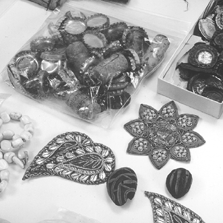

by Rosemary Edmiston
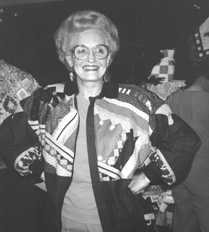
Dottie Sweet models her Bomber Bonanza jacket, which is available in pattern form. (Photo courtesy of Dottie Sweet.) Below left, the bottle caps, and Below right, Dottie in her workshop. (Photos by Brandi Easter)
Among Dottie Sweet's collection of colorful fabrics, beads and unusual artifacts gathered during her travels to far-flung places is a box of bottle caps, all of them flattened and many corroded and rusted.
Sweet plans to use the caps, bearing such words as Coors or the letters MGD, in a garment of "wearable art."
"The more rusty and more squashed they are, the more interesting," she said. "I'm going to make a jacket with these old pieces on it. And I've gathered these from everywhere -- Yosemite and Yellowstone and Nepal."

In her Eureka studio, Sweet also has a collection of what she calls collage neckpieces -- original designs accentuated, for example, by a turquoise nugget from Tibet, an elephant carving from Africa, the figure of a Himalayan god and -- well -- a long piece of discarded woven thread she found while out for a walk in her neighborhood.
It was lying in the roadway, said Sweet, who recalled proudly displaying the find to her daughter upon returning home. "She says 'Mother, do you know what that is? That's the back of an old rug that's just kind of torn apart.' And I thought well, you know, I still like it. And I thought it made a really interesting piece."
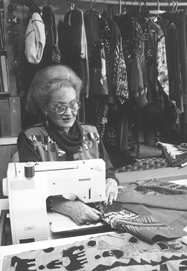
"I'm always looking," she said, holding another neckpiece. "This is a piece of bark off of a palm tree that I found down in Southern California, so I added that,"
The words Sweet lives by are carefully written on a small piece of paper taped to the outside of a fabric storage cabinet in her Eureka home: "Don't do predictable things -- add something unusual -- a bright unexpected color or _______?"
The blank space says more about Sweet than a dozen adjectives could.
Also an accomplished painter who has shown her work locally and in Southern California, Sweet said she can't help but collect all types of material to add to her artwork.
"That's just part of me. Not that I'm looking for my business, I'm just so interested in everything. I think being an artist you see more than other people see."
Artist, teacher, world traveler, mother and wife, Sweet has created a line of clothing, jewelry and accessories that has been displayed at the Museum of Man and Bazaar Del Mundo, both in San Diego, as well as in numerous fashion shows including the Convention of the International Federation of University Women at Stanford University in Palo Alto.
Locally, her work will be shown throughout February at the Carnegie Building in Eureka.
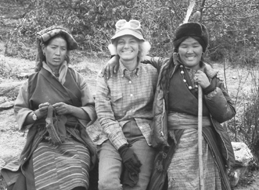
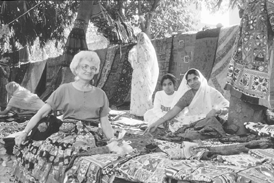
Sweet's line of wearable art has an ethnic flavor, with many of the pieces made from clothing or bits of fabric the Southern California native picked up while traveling to Nepal, Tibet, India, Greece, Thailand, Mexico, Guatemala and Japan. Beads, seeds, trinkets, coins and the unusual -- from a tassel once worn by a camel to carved avocado seeds -- are used in the making of her unique creations. For the artist, a piece of oddly cut leather tossed aside by another becomes the basis for a neck collage.
Sweet's expansive home is filled with her finds. In her dining room an ikat tablecloth from Indonesia covers the table. Pillows on the couch are fashioned from batiks, also found in Indonesia, and a wall hanging over the fireplace is from Burma. Shisha mirror fabric from India covers a smaller table and three huipils -- a garment worn by Guatemalan women -- adorn a wall. In every corner is a reminder of one trip or another.
Evidence that Sweet has a gift for turning what most people see as junk into art can be found in her newly remodeled kitchen. Embedded above the sink and in spots on the walls are refinished legs from what once was a stately table. She found them discarded and dirty in an old barn in Colorado.
"Don't call them junk," Sweet teases while describing uses for various items she's amassed. "They're interesting found pieces."
Sweet's artistic nature can be traced to her parents and childhood on Balboa Island near Newport Beach. Her mother loved to paint and sew. Her father, a plumber, was a cartoonist and toy maker who designed the family's birthday cards over the years and made toys for his three daughters.
"My mother did a lot of sewing because she had three girls. And I usually wore left over clothing from my sisters. But she would kind of redesign and remake them for me so I didn't feel like I was wearing hand-me-downs so much."
Sweet's passion for design was evident by the time she was 8 years old.
"What I used to do mostly is I made paper dolls, a lot of paper dolls. ... I didn't play with them, I just designed all these clothes for them," she said.
As a young woman she was dazzled by movie stars and their clothing and dreamed of becoming a costume designer. She studied in that field for more than two years at San Jose State University, but transferred to the University of California at Davis and San Diego State University, changing her major to teaching.
In an artist's statement which accompanies her work, Sweet wrote that "reality conquered my youthful aspirations" -- she wouldn't have been able to make a living in clothes design, she said.
It was teaching that brought Sweet to Humboldt County in 1948. She was newly married to her now deceased husband Bob Stocum and still in college in Southern California when an aunt and uncle from Weitchpec told her of two jobs opening at country schools in the Hoopa area, 20 miles apart.
Adventurous lovers of the outdoors, the young couple picked up and moved. It wasn't until they had arrived in town that two teaching positions opened at the same school "clear down at the end of the road" in Pecwan. They took the jobs, planning to stay for the year. "We thought it would be fun, but never with the idea that we would stay (in Northern California)," Sweet recalled. That was more than 50 years ago.
For three years the young couple lived and worked at Pecwan School, Dottie teaching kindergarten through third grades and Bob teaching the older students; he was also the principal and bus driver.
The remote community, then located on the Hoopa Indian Reservation, was predominantly American Indian, a great influence in Sweet's art.
An outdoorswoman who had grown up hunting with her father, Sweet wasn't intimidated by the ruggedness of the country. At the time the road to Pecwan was a rough, one-way dirt lane. Salmon still ran up Pecwan Creek, and a snow storm could seal off the community for days.
Sweet recalled first seeing the sight of hundreds of salmon in the stream. "I got so excited ... I ran back to the house and got my .22 and shot one of them from the bridge." She then jumped into the water fully clothed and got hold of the injured fish, much to the amusement of four children who had accompanied her.
"The tail was going like this," she said weaving her hands. "The kids were just laughing and laughing. They thought it was so funny. And, of course, in those days we didn't have any game wardens out there."
The couple later moved from Pecwan to Eureka when Sweet became pregnant with their first child. "They said, 'Oh, won't you please stay because you can have your baby ... and you can nurse him and we'll get an Indian lady to come and take care of him.' It was very tempting," Sweet said, "but it was just so far away from any medical help and I just wasn't sure I wanted to do that. Looking back on it now with what I know I'm kind of sorry we didn't.
"We just enjoyed it so much," she said of her tenure at the tiny school. "Pecwan was the highest paid school district in California at that time because of the timber industry. We had everything and anything we wanted. We didn't have electricity, but we had a generator."
The Stocums had also become an important part of the community and made numerous friends. "We started having a function (at the school) for every occasion to bring all the families together," Dottie recalled.
They would also attend Indian ceremonial events, where the one-time costume design major could admire the elaborate costumes of the Hoopa, Yurok and Karuk people.
"They did beautiful basketry," said Sweet, who studied basket making herself with an Indian woman. "I raised all three of my children in Indian baskets."
After having her first son, Sweet and her husband went on to teach at Klamath School and Somes Bar. Sweet later taught in Eureka City Schools' special education program for developmentally disabled adults and extension programs through College of the Redwoods and the University of California at Davis. And several years ago she had the opportunity to lead an art class in a Nepal orphanage.
"It was really interesting because none of them spoke any English. The other teacher there would interpret."
Her wearable art reflects the bright colors and adornments of South Asia and American Indian costumes, as well as the cultures of Mexico and the Southwestern United States.
For Sweet, the brighter the fabric, the better.
At the Carnegie she displays 30 garments ranging from an elegant white dress made of East Indian shisha mirror fabric to a colorful denim bomber jacket from a pattern designed by the artist.
"People ask me if I stay awake at night thinking up these ideas," she said. "When I'm working on a fashion show or something like that, I'll wake up at 2 or 3 o'clock in the morning and I come up here (to my studio) and work. ... I get too excited about what I'm doing, so I decide it's probably just as well."
Her collection also includes items made from mud cloth she purchased during her travels to Africa with her husband of nearly 20 years, Ray Sweet, a neighbor whom she met at a block party three years after her first husband died.
"The way they make it is they take mud and urine and paint a design," she explained. The fabric is dried in the sun and washed, resulting in an interesting pattern that "doesn't smell at all," Sweet said smiling.
The Carnegie show, "Dottie Sweet: Around the World With Fiber Arts," is being presented through the Humboldt Arts Council from Feb. 7-24. Sweet will also teach a collage neckpiece workshop on Feb. 14 at the Carnegie. Call 442-0278 for further information. n